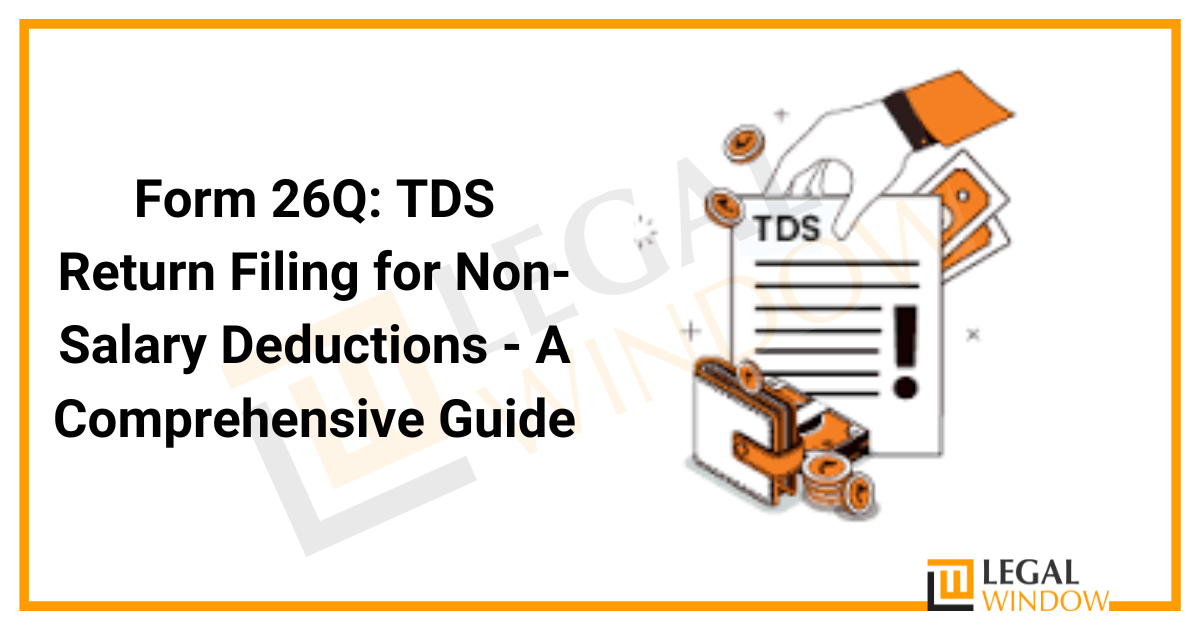Form 26Q: TDS Return Filing for Non-Salary Deductions – A Comprehensive Guide
- June 19, 2023
- Income Tax

Tax Deducted at Source (TDS) is a mechanism implemented by the Indian government to collect tax at the source of income generation. It ensures a steady flow of revenue for the government and reduces tax evasion. TDS is deducted from various types of income, including salaries, interest payments, rent, and professional fees. In this article, we will specifically focus on Form 26Q: TDS Return Filing for Non-Salary Deductions and provide a comprehensive guide to help you navigate the process.
Meaning of Tax Deducted at Source (TDS)
Tax Deducted at Source (TDS) is a mechanism introduced by the tax authorities to ensure the collection of taxes at the source of income itself. It requires individuals or entities making specified payments to deduct a certain percentage of the payment as tax before making the payment to the recipient. TDS plays a crucial role in the Indian tax system, and its proper filing is of utmost importance.
TDS, as the name suggests, involves deducting tax from various types of payments at the time of making such payments. The person who deducts the TDS is known as the “deductor,” and the person from whose payment TDS is deducted is called the “deductee.” The deducted TDS amount is then deposited with the tax authorities by the deductor. The deductee can claim credit for the TDS amount deducted while filing their income tax return.
TDS can be deducted on various types of payments, including salaries, interest, rent, professional fees, commission, and contractual payments. The rates at which TDS is deducted vary depending on the nature of the payment and the relevant provisions of the Income Tax Act, 1961. Failure to deduct TDS or non-compliance with TDS provisions can result in penalties and legal consequences for the deductor.
Importance of filing Tax Deducted at Source (TDS)
The following are the importance of filing TDS:
- Ensures Adequate Revenue Collection: TDS acts as a tool for the government to ensure the timely and adequate collection of taxes. By deducting tax at the source, the tax authorities can prevent tax evasion and enhance the efficiency of tax administration. It helps in achieving a steady revenue stream for the government, facilitating the funding of public welfare initiatives and infrastructure development.
- Encourages Tax Compliance: TDS plays a significant role in encouraging tax compliance among taxpayers. By making it obligatory for deductors to deduct TDS and deposit it with the authorities, it creates a sense of responsibility and accountability. It ensures that taxpayers fulfill their tax obligations and discourages the practice of underreporting income.
- Eases Tax Burden: TDS operates on the principle of spreading the tax liability over multiple transactions. By deducting tax at the time of payment, the burden of paying a substantial amount of tax at once is reduced for the deductee. The deducted TDS amount can be adjusted against the total tax liability at the time of filing the income tax return, making the tax payment process more manageable.
- Facilitates Transparency: TDS promotes transparency in financial transactions. Since TDS requires deductors to provide a TDS certificate to the deductee, it acts as proof of tax deduction. The deductee can cross-verify the details of TDS deducted with their own records and ensure that the tax deducted matches their income. This transparency helps in building trust between taxpayers and the tax authorities.
- Simplifies Tax Compliance: Filing TDS can streamline the tax compliance process for both the deductor and the deductee. It ensures that the deductor complies with the TDS provisions by deducting and depositing tax on time. For the deductee, TDS serves as a prepayment of their tax liability, simplifying the process of calculating and paying taxes at the time of filing the income tax return.
Form 26Q: TDS Return Filing for Non-Salary Deductions
Form 26Q and TDS return filing play a significant role in ensuring proper TDS compliance for non-salary deductions. Deductors should diligently fill out Form 26Q, accurately report TDS deductions, and file TDS returns within the specified due dates.
Let us now, move on to discuss about Form 26Q and about Non-Salary Deduction in greater detail.
What are Non-Salary Deductions?
Non-salary deductions refer to any payments made to individuals or entities other than employees. These deductions can include payments made to contractors, professionals, service providers, and vendors. Non-salary deductions are subject to TDS as per the Income Tax Act, and the deductor is responsible for deducting and depositing the applicable TDS amount to the government.
Obligations for TDS Return Filing for Non-Salary Deductions
If you are a deductor who has made non-salary deductions and deducted TDS on such payments, you are required to fulfill certain obligations related to TDS return filing. These obligations include:
- Obtaining a Tax Deduction and Collection Account Number (TAN): Before deducting TDS, you must obtain a TAN from the Income Tax Department. TAN is a unique 10-digit alphanumeric number that identifies the deductor in all TDS-related transactions.
- Deducting TDS: As a deductor, you are responsible for deducting TDS at the prescribed rates from non-salary payments exceeding the threshold limits specified by the Income Tax Act. The TDS rates may vary depending on the nature of payment.
- Depositing TDS: After deducting TDS, you must deposit the TDS amount to the government within the specified due dates. The deposited amount must be accompanied by a challan specifying the relevant details.
- Filing TDS Returns: The next step is to file TDS returns with the Income Tax Department. TDS returns provide a summary of TDS deducted and deposited during a particular period. They also include details of deductees (recipients of payments) and the TDS certificates issued to them.
TDS Return Forms for Non-Salary Deductions
TDS return filing is the process of submitting the TDS statements to the Income Tax Department. It is mandatory for all deductors who have deducted TDS to file their TDS returns accurately and within the specified due dates.
For Non-Salary Deductions, the deductor needs to file TDS returns using Form 26Q. The TDS return summarizes the TDS deducted and deposited by the deductor during a particular quarter. It helps the government in verifying the TDS amounts and ensures that the deductor is compliant with the TDS provisions.
The TDS returns for non-salary deductions are filed using different forms, depending on the nature of the deductor and the type of payment. The commonly used TDS return forms for non-salary deductions are:
- Form 26Q: This form is used for non-salary TDS deducted by a deductor other than the government.
- Form 27Q: This form is used for non-salary TDS deducted on payments made to non-resident individuals or entities.
What is Form 26Q?
Form 26Q is a TDS return form that is filed for non-salary payments made to Indian residents. It covers various types of payments, such as rent, professional fees, interest, commission, contract payments, etc., which attract TDS under different sections of the Income Tax Act, 1961. The form captures details of deductees, deductor, and the TDS amounts deducted and deposited.
Significance of Form 26Q
Filing Form 26Q accurately and within the stipulated time frame is essential for several reasons:
- Compliance with Tax Laws Form 26Q ensures compliance with the provisions of the Income Tax Act. Failing to file or submitting an incorrect form may attract penalties and interest.
- Transparency and Accountability The form provides transparency in the TDS deduction and deposit process. It enables the tax authorities to cross-verify the details of TDS deducted by the deductor and the TDS credit claimed by the deductee.
- TDS Credit for Deductees The TDS details mentioned in Form 26Q enable the deductee to claim credit for the TDS deducted while filing their income tax returns. It helps in avoiding double taxation on the same income.
- Streamlined Tax Administration Form 26Q plays a crucial role in maintaining accurate records of TDS deducted and deposited. It assists tax authorities in effective tax administration, including tax assessment, scrutiny, and reconciling the TDS details provided by deductors and deductees.
Components of Form 26Q
Form 26Q consists of several sections and columns that need to be filled accurately to ensure compliance with tax regulations. Let’s understand the important components of the form:
- Tax Deductor and Deductee Details This section requires the tax deductor to provide their TAN (Tax Deduction and Collection Account Number) along with their name, address, and contact details. The deductee’s PAN (Permanent Account Number) and details like name, address, and contact information are also required.
- Challan Details Here, the tax deductor needs to provide the details of the challan through which TDS has been deposited. The challan number, BSR code of the bank, date of deposit, and the total amount deposited need to be mentioned.
- Payment-wise Breakup of TDS Deducted This section captures the payment-wise details of TDS deducted. It includes the nature of payment, the section under which TDS is deducted, the rate at which TDS is deducted, the amount paid, and the TDS amount deducted.
- Annexure I and Annexure II Annexure I contain details of deductees whose TDS has been deducted on various payments, while Annexure II captures details of deductees for whom no TDS has been deducted due to invalid PAN or non-furnishing of PAN.
Procedure for TDS Return Filing for Non-Salary Deductions
The process of filing TDS returns for non-salary deductions involves the following steps:
- Download the Relevant TDS Return Form: Visit the official website of the Income Tax Department or the TIN-NSDL website to download the applicable TDS return form (Form 26Q or Form 27Q).
- Prepare the TDS Return: Fill in the necessary details in the TDS return form, including the deductor’s information, deductee details, and TDS amount deducted and deposited.
- Validate the TDS Return: Validate the TDS return using the File Validation Utility (FVU) provided by the Income Tax Department. The FVU ensures that the return is error-free and ready for submission.
- Generate the TDS Return File: After successful validation, generate the TDS return file in the specified format (typically in .txt format).
- Submit the TDS Return: Log in to the official website of the Income Tax Department or the TIN-NSDL website and upload the TDS return file. Alternatively, you can submit the physical copy of the return to the designated TDS center.
- Receive the Acknowledgment: Once the TDS return is successfully submitted, you will receive an acknowledgment containing a unique 15-digit acknowledgment number. This number serves as proof of filing the TDS return.
- Issue TDS Certificates: Issue TDS certificates (Form 16A or Form 16B) to the deductees, providing them with details of the TDS deducted on their payments.
Due Date for TDS Return Filing for Non-Salary Deductions
The due dates for filing TDS returns vary based on the quarter in which the deductions were made. Typically, the due dates are as follows:
- Quarter 1 (April to June): July 31st
- Quarter 2 (July to September): October 31st
- Quarter 3 (October to December): January 31st
- Quarter 4 (January to March): May 31st
Non-compliance with TDS return filing can lead to penalties and other legal consequences. It is crucial for deductors to stay updated with the latest guidelines and adhere to the due dates to avoid any penalties.
Important Points to Consider
The following are some of the important points to consider:
- Ensure that TDS is deducted and deposited within the specified due dates to avoid any interest, penalties, or legal consequences.
- Maintain proper records of TDS deductions, deposits, and returns for future reference and audit purposes.
- Regularly reconcile TDS deducted with TDS deposits and rectify any discrepancies promptly.
- Stay updated with the latest notifications and amendments related to TDS provisions to comply with the applicable rules and regulations.
Conclusion
Filing TDS Returns for non-salary deductions is a crucial responsibility for deductors to ensure compliance with the Income Tax Act, 1961. By understanding the obligations, following the correct procedures, and staying updated with the relevant regulations, deductors can fulfill their TDS Return Filing requirements efficiently.
It is advisable to seek professional advice or consult the official resources of the Income Tax Department for any specific queries or clarifications regarding TDS return filing for non-salary deductions.
You can also consult with the Tax Experts at Legal Window, in case of any issue or query regarding TDS Return Filing for Non-Salary Deductions. Our Experts would be Happy to Help.
CA Pulkit Goyal, is a fellow member of the Institute of Chartered Accountants of India (ICAI) having 10 years of experience in the profession of Chartered Accountancy and thorough understanding of the corporate as well as non-corporate entities taxation system. His core area of practice is foreign company taxation which has given him an edge in analytical thinking & executing assignments with a unique perspective. He has worked as a consultant with professionally managed corporates. He has experience of writing in different areas and keep at pace with the latest changes and analyze the different implications of various provisions of the act.
Categories
- Agreement Drafting (23)
- Annual Compliance (11)
- Change in Business (36)
- Company Law (148)
- Compliance (90)
- Digital Banking (3)
- Drug License (3)
- FEMA (17)
- Finance Company (42)
- Foreign Taxation (6)
- FSSAI License/Registration (14)
- GST (118)
- Hallmark Registration (1)
- Income Tax (200)
- Latest News (34)
- Miscellaneous (164)
- NBFC Registration (8)
- NGO (14)
- SEBI Registration (6)
- Section 8 Company (7)
- Start and manage a business (21)
- Startup/ Registration (130)
- Trademark Registration/IPR (40)
Recent Posts
- NGO Darpan Registration in Jaipur May 2, 2024
- Registration of Charges with ROC May 1, 2024
- Post incorporation compliances for companies in India April 30, 2024
About us
LegalWindow.in is a professional technology driven platform of multidisciplined experts like CA/CS/Lawyers spanning with an aim to provide concrete solution to individuals, start-ups and other business organisation by maximising their growth at an affordable cost.









